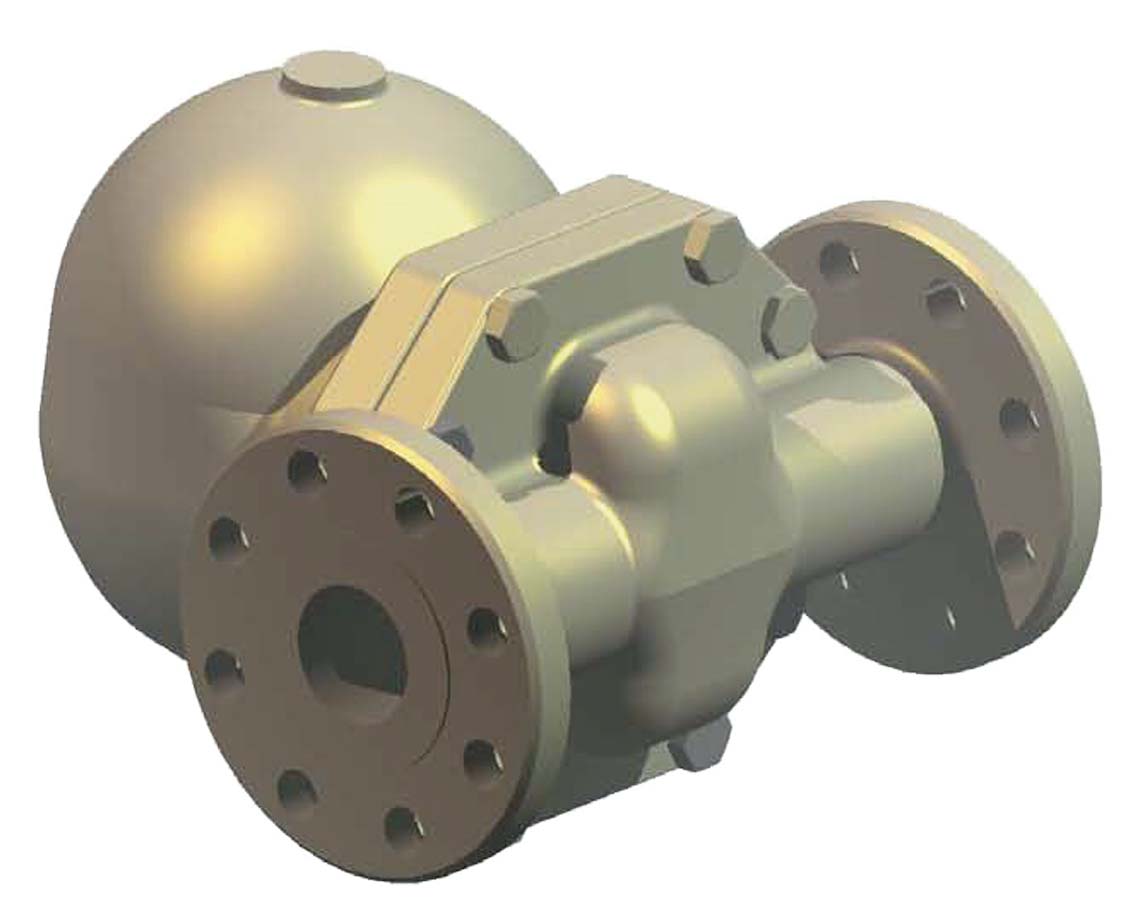How It Works: Steam Traps
Published: 01/09/2015

How It Works: Steam Traps
Published: 01/09/2015

The American National Standards Institute defines a steam trap as a “self-contained valve that automatically drains the condensate from a steam-containing enclosure while remaining tight to live steam, or if necessary, allowing steam to flow at a controlled or adjusted rate. Most steam traps will also pass noncondensable gases while remaining tight to live steam.”
This type of valve has been in use since the early 1800s following the Industrial Revolution, when steam became more widely used as a heating medium instead of a motive source. There are three basic criteria for a valve to be considered a steam trap:
- automatically discharges condensate
- does not leak steam
- can also discharge noncondensable gases, such as air.
Steam traps are used in heating applications where latent heat is created and conveyed to a specific product (e.g., heating crude oil to decrease viscosity). Once the latent heat or energy has been transferred to the product from the steam, the steam condenses and forms condensate. If this condensate is not effectively removed from the process, the efficiency of the system will suffer.
A steam trap works to remove condensate and noncondensables without removing the steam. Manually throttling standard valves to allow only the condensate to escape is time consuming and inefficient. Manual valves must be constantly adjusted to take account of varying steam loads and the external environment; as a result, the risk of losing steam is much higher. Steam traps serve as a solution.
Mechanical traps
Mechanical traps sense the difference in density between steam and condensate. Condensate from this type of trap is continually discharged, leaving none to hinder the process. These types of traps are the most commonly used in systems that require large discharge capacities, such as process applications.
The bucket trap uses an inverted bucket as a float device, and a linkage connects the bucket to the valve head. When steam or air enters the bucket, the bucket gains buoyancy and closes the valve. Condensate causes the bucket to lose buoyancy and sink, opening the valve and allowing the removal of the condensate.
The floating ball trap is a similarly simple mechanical trap. The weight of the ball, acting through a lever, keeps the valve closed when there is no condensate. As the condensate enters the trap, it raises (floats) the ball and opens the valve. When the condensate has been discharged, the ball drops back down and closes the valve. This type of trap is unable to discharge air, so a thermostatic air vent is installed inside the body of the valve for this purpose.
The Cameron portfolio of DOUGLAS ITALIA steam trap and strainer technologies offers both inverted bucket and floating ball traps.

Thermostatic traps
Thermostatic traps use a temperature-sensing element to determine when to discharge the condensate. Because of this, all thermostatically operated steam traps will cause condensate to back up in the system. In addition, they handle air and noncondensables extremely well because the valves are open on startup when the system is relatively cool.
Balanced-pressure traps operate by balancing the steam pressure and internal pressure of the thermostatic element (e.g., a bellows), which is partially filled with a volatile liquid with saturation temperature that is slightly lower than that of water. At startup, the trap is wide open, discharging condensate and noncondensables. As the temperature approaches that of the steam, vaporization of the volatile liquid creates a pressure differential, causing the bellows to expand and close the valve against its seat. As the condensate cools, the volatile liquid condenses and lowers the internal pressure on the bellows, causing it to retract and open the valve, permitting the condensate discharge cycle to continue. Examples of this include the Model TZ and Model TJ traps in the DOUGLAS ITALIA steam trap and strainer technologies portfolio, which can be used in steam tracing applications.
Bimetallic trap operation is based on the characteristic that two dissimilar metals have different expansion rates. When the bimetallic element is heated, the different expansion rates of the metals causes it to deflect or bend, which provides movement to close a valve. Examples of this type of trap include the Model BB and Model BV traps in the DOUGLAS ITALIA steam trap and strainer technologies portfolio, which can be used in steam tracing and superheated steam main applications.
Thermodynamic traps
Thermodynamic traps use the difference in velocity between steam and condensate to operate. Condensate entering the steam trap body moves relatively slowly compared with steam and is freely discharged through a valve (a free floating disk). When steam reaches the underside of the disc, its velocity is much higher than that of condensate, creating a pressure drop that closes the valve head. The valve stays shut until the steam pressure above the disc drops, allowing the valve to open and the discharge cycle to repeat. The Model DA in the DOUGLAS ITALIA steam trap and strainer technologies portfolio is an example of this type of trap, which can be used in steam mains and steam tracing applications.
Applications
Steam traps can be used anywhere there is a steam system and a need to discharge condensate.
Oilfield applications
- Bulk storage tanks
- Pressure reducing valve stations
- Steam mains
- Steam tracing
- Process heaters (heat exchangers and reboilers)
Industrial applications
- Industrial dryers (multibank pipe dryers and rotating cylinders)
- Laundries (garment presses and dry cleaning machines)
- Space heating
- Steam mains
- Steaming ovens
- Bulk storage tanks
- Process equipment (boiling pans, retorts, digesters, coppers, reboilers, evaporators, and vulcanizers)
- Space heating (heat exchangers, radiant panels, unit heaters, air heater batteries, and overhead pipe coils)
- Process vats
- Autoclaves
